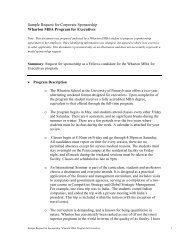FEATUREFEATUREILLUSTRATION / JONATHAN CARLSONT HEBUSINESSOFHEALTHCARELAST FALL, WHARTON’S HEALTH CARESYSTEMS DEPARTMENT CELEBRATED ITS 25 THANNIVERSARY. FACULTYANDALUMNIHAVELEDTHE EFFORT TO LINK THE DISCIPLINESOF ECONOMICS AND MANAGEMENT TO THEPRACTICE OF MEDICINETo understand why <strong>Wharton</strong>’s <strong>health</strong> <strong>care</strong> management programwas first established in 1970, and why it has been sosuccessful in educating undergraduate, MBA and doctoralstudents, it helps to know some of the history.For example:■ In 1965, the year Medicaid and Medi<strong>care</strong> were passed,<strong>health</strong> <strong>care</strong> represented six percent of the Gross DomesticProduct. Today, it is a trillion dollar industry — the largestin the nation — totaling 13.9 percent of GDP.■ In 1967, the Leonard Davis Institute of Health Economicswas established with a gift from Leonard Davis, founderof Colonial Penn Insurance Co. LDI’s mission was, and is,to serve as a multidisciplinary research institute focused onthe economic, behavioral and public policy aspects of <strong>health</strong><strong>care</strong> delivery and financing.The visionary behind LDI, which is recognized as the precursorto the <strong>health</strong> <strong>care</strong> systems department, was foundingdirector Robert Eilers, professor of insurance at <strong>Wharton</strong>and of community medicine in the School of Medicine untilhis death in 1974 at age 43.“Eilers more than anyone established LDI as a universitywideinstitute specifically with the mission of bridgingmedicine and <strong>Wharton</strong>,” says William Kissick, chairman ofLDI’s governingboard. “And it wasEilers who decided early on that if the institute was going tohave credibility in <strong>Wharton</strong> it had to have an educationalcomponent.” That meant an MBA program — and later undergraduateand doctoral programs — with the specific goal oftraining managers and analysts of <strong>health</strong> <strong>care</strong> systems.■ In 1970, the <strong>Wharton</strong> faculty approved the creation of agraduate <strong>health</strong> <strong>care</strong> management program at <strong>Wharton</strong>. Atthe time, says Mark Pauly, Bendheim Professor of HealthCare Systems and vice dean of doctoral programs at <strong>Wharton</strong>,<strong>health</strong> economics in the minds of Leonard Davis andmany others meant cost containment. The passage ofMedi<strong>care</strong> and Medicaid two years earlier had unleashed thepayment of billions of dollars in state and federal reimbursementsto hospitals and doctors who provided <strong>health</strong><strong>care</strong> to the poor, elderly and handicapped. By 1967, lack ofeffective constraints on these programs had caused <strong>health</strong>relatedinflation to skyrocket.“Health <strong>care</strong> was a non-system,” says Arnold Rosoff, professorof legal studies and <strong>health</strong> <strong>care</strong> systems. “All theelements were functioning separately. The delivery of <strong>care</strong>was not linked to the payment of <strong>care</strong>. Medicine was dom-inated by physicians who had no economics backgroundand no training as managers.”Another area of interest to LDI founders in the late1960s was universal insurance coverage <strong>for</strong> <strong>health</strong> <strong>care</strong>services. Medi<strong>care</strong> and Medicaid together covered about20 percent of the population while private employer-basedcoverage spread rapidly to most employees and their dependents.Yet millions of other Americans who didn’t qualify<strong>for</strong> Medicaid but couldn’t obtain <strong>health</strong> insurance fellbetween the cracks. Although Congress gave serious considerationto national <strong>health</strong> insurance in 1974 and againin 1993, no legislation was approved and universal coverageremains an elusive goal.Last fall, the <strong>health</strong> <strong>care</strong> systems department celebratedits 25th anniversary. Cost containment and<strong>health</strong> <strong>care</strong> <strong>for</strong> the uninsured are still two of the majorchallenges facing the industry, but they have beenjoined by the equally important issues of qualityassurance and technology assessment. Meanwhile,phrases used by <strong>Wharton</strong> planners in 1970 to framethe issues are now common language in the<strong>health</strong> <strong>care</strong> debate: Patients are referred toas consumers of <strong>health</strong> <strong>care</strong>; doctorsand hospitals are referred to asproviders; managed <strong>care</strong> is a relativelynew term that holds outthe promise of controlling <strong>health</strong>costs through the use of provider-targetedincentives and directives.The rationale <strong>for</strong> placing a <strong>health</strong> <strong>care</strong> program in a businessschool — essentially linking medicine to the disciplinesof economics and management — has clearly been justified.“Our program exists because <strong>health</strong> <strong>care</strong> does respond to market<strong>for</strong>ces,” says Patricia Danzon, Celia Z. Moh Professor ofHealth Care Systems, professor of insurance and risk management,and chair of the <strong>health</strong> <strong>care</strong> systems department.“Competitive pressures have become much more aggressiveand management skills have become essential.”T HE ISSUESKissick compares today’s <strong>health</strong> <strong>care</strong> industry to an onion.“Every time you peel something away, there is another layer... and the more you peel, the more layers there are,” he says.“In 1965, I totally understood the American <strong>health</strong> <strong>care</strong>enterprise — its system, the financing, everything. I had myarms around it. I can’t do that today. It is so complex andit is changing so rapidly.”One of the biggest drivers of this change has been theadvent of insurance products with different kinds of incentives<strong>for</strong> the behavior of physicians and patients. These can rangefrom the pre-hospitalization testing that some insurers requireto a staff model HMO where physicians are employees of theplan to an Independent Practice Association (IPA) where physiciansgroups contract with an outside carrier.John Ferry, MD, WG’82, presidentand CEO of SouthamptonHospital in Southampton, NY.Southampton Hospital is a 194-bed community hospital in asemi-rural resort area known asThe Hamptons on Long Island, NY.Because of its location, “we have oneof the wackier staffing and organizationalproblems I’ve heard of,” noteshospital president and CEO JohnFerry, WG’82.Year-round, the population isabout 80,000, consisting mainlyof retirees, farmers, fishermen andservice people <strong>for</strong> the local economy.In the summer, the populationbulges to 300,000, including actorsand actresses, movie directors, WallStreet investors, models and so <strong>for</strong>th.Finally, about a mile from the hospitalis an Indian reservation.If that sounds complicated, thechallenges are only beginning.Southampton Hospital is about tomerge with two others “to allow us tosurvive,” says Ferry, who has beenCEO of the $55 million facility <strong>for</strong>approximately two years. “Be<strong>for</strong>e Icame here, the hospital was losingclose to $3 million a year. Last yearwe lost about $643,000. This yearwe will make a profit. But I don’t feela false sense of security because Ican’t tighten the belt anymore.”Add to that the likelihood that thehospital will take a multimillion dollarhit from Medi<strong>care</strong>/Medicaid re<strong>for</strong>m,“and you can see why economies ofscale” are appealing, he notes.Still unclear is who will be CEO ofthe newly merged entity and where itwill be located — in one or more ofthe existing facilities or on a totallynew site.In the midst of this uncertainty,Ferry, who was trained in medicalschool as a pediatrician, offers somethoughts on <strong>health</strong> <strong>care</strong>:“I have a lot of hope <strong>for</strong> the ideaof provider-sponsored networks,” henotes. These networks, composed ofdoctors and hospitals, would start takingon some of the financial risk ofproviding <strong>health</strong> <strong>care</strong>, “which is whatthe insurance companies are trying toget us to do anyway, except that theywant to take some of the profits.”Working with insurers, Ferrynotes, does have benefits: Insurersoffer marketing, which hospitals“don’t exactly excel at,” and theyoffer in<strong>for</strong>mation systems that areclinical and claims-based, and relatespecifically to physician activity. Thisallows insurers to sift through in<strong>for</strong>mationsystems to come up withtrends, develop profiles on patientsand doctors, and so <strong>for</strong>th.“But the technology is transportable,”Ferry says. “Insurancecompanies don’t have a lock on it.Provider networks could very welldevelop this on their own.”Another implication of these networksis that physicians over 40 whowent into medicine to be their ownbosses will no longer be practicing theway they expected to,” Ferry adds.“Instead, they will work in groups.Also, patients will have less choice,which they will come to expectbecause they will be paying less, andthey will also have to drive farther toget services.“It’s a disruptive scenario, but inthe end will we be much worse off?No, not in terms of what people callmedical <strong>care</strong>. And there may well bepluses, such as an emphasis on outcomesmeasurement, which meansthat as physicians we can no longersay we are doing a good job, we haveto prove it .”“Back in 1970, cost containment looked like an insuperableproblem,” says Pauly. “But with the spread of managed<strong>care</strong>, there seems to be evidence that costs are, at the very6W INTER 19967WHARTON ALUMNI MAGAZINE
FEATUREleast, increasing at a slower rate, that insurers aren’t paying<strong>for</strong> unnecessary procedures and treatments, and that wasteand inefficiency have been reduced.”Lynn C. Bongiorno, WG’95,manager, medical delivery systems,Ox<strong>for</strong>d Health PlansLynn Bongiorno chose to work <strong>for</strong>Ox<strong>for</strong>d Health Plans because, shesays, “HMOs are driving where the<strong>health</strong> <strong>care</strong> dollars are being spent.”Ox<strong>for</strong>d has 3,000 employees andclose to one million members in Connecticut,New Jersey and New York.The organization, based in Norwalk,Conn., recently expanded into NewHampshire and Pennsylvania. Bongiornois in charge of negotiatingcontracts with ancillary vendors suchas laboratories and home <strong>care</strong> companies.“I’m trying to change thewhole contracting system to bringcost, access and quality into the negotiation.It will allow us to make betterdecisions about what services to bringinto our network, in what geographicregion and at what price,” she says.“Ultimately we are trying to use analyticaltechniques to link the wholesystem back into quality.”From Bongiorno’s perspective, thetwo biggest issues in <strong>health</strong> <strong>care</strong> thesedays are the unchecked use of medicaltechnology and the inevitabilityof rationing <strong>care</strong>. “Technology is amajor culprit behind the cost increases,”she says. “The challenge is to figureout the appropriate use of technologyby applying statistical analysisto determine the best outcomes. Italso means working with doctors aspartners and trying to educate themregarding our results.”In the area of rationing, Bongiornosays, “HMOs are trying toaccomplish it in a logical and efficientway. You put together a list of protocolsso that clinical judgments canbe made about what to cover andwhat not to cover. When is somethingexperimental, when is it medicallyunnecessary, and so <strong>for</strong>th. Our goalis not to give directives to physicians,but to capture in<strong>for</strong>mation and domore outcomes measurement so thatwe can then in<strong>for</strong>m and educate doctorsabout the appropriateness ofcertain types of <strong>care</strong>.”Another target of <strong>health</strong> <strong>care</strong>re<strong>for</strong>m, says Bongiorno, is the typicalhospital system which “isn’t yet runlike a business. Hospitals tend tohave too many people doing veryfinite tasks with an inordinate amountof equipment. They don’t crosstraintheir employees to do different jobsin ways that would create a morepatient-focused environment.“Until hospitals can run themselvesmore efficiently, we don’t wantto share risk with them,” says Bongiorno.“They are too expensive.”As part of its own <strong>health</strong> <strong>care</strong>re<strong>for</strong>m ef<strong>for</strong>ts, Ox<strong>for</strong>d three yearsago developed a concept called grouppractices without walls. It calls <strong>for</strong>the establishment of private practicepartnerships in which doctors remainindependent and have their ownoffices, but also agree to share therisk with Ox<strong>for</strong>d of providing <strong>care</strong>.“For every member who signs upwith a primary <strong>care</strong> physician in oneof these partnerships, we put an actuariallydetermined number of dollarsinto a fund. The physician keeps whatis left in the fund at the end of thequarter. We don’t police the physicians.They make all their owndecisions, and they operate independently,but they have the same incentiveswe do. They assume some ofthe risk.”Ox<strong>for</strong>d now has about 120 ofthese physician practice partnerships,each with 25 to 50 doctors. Theywork “astonishingly well,” says Bongiorno.The managed <strong>care</strong> revolution is part of an ongoingrestructuring that has turned the whole <strong>health</strong> <strong>care</strong> deliverysystem on its head. Added to the recent increase inhorizontal mergers — between hospitals, managed <strong>care</strong> systemsand insurers, <strong>for</strong> example — has been an even morepronounced interest in vertical mergers, where a continuumof <strong>care</strong> is provided through the merger of, <strong>for</strong> example,a hospital system, a physician practice, a nursing home anda home <strong>health</strong> facility.“This is a new level of integration,” Danzon says. “What’sgood is that it’s being driven by pressures in the marketplace,not by the political system. The physician group that wantsto hold out as an independent practice is going to lose marketshare. The reason hospitals are buying physician practicesand setting up feeder networks is so that they can play in thisnew arena. You have to participate if you want to survive.”A key concept in <strong>health</strong> re<strong>for</strong>m is the idea that risk oughtto be shared by those who provide the service. Many physiciansgroups are already operating under incentive systemswhere they promise to deliver whatever <strong>care</strong> is needed <strong>for</strong> apre-determined capitation fee per patient, notes June Kinney,associate director of the <strong>health</strong> <strong>care</strong> systems department since1981. “What’s new is that hospitals are beginning to have tocapitate <strong>care</strong> [beyond primary <strong>care</strong>] <strong>for</strong> specialized services,such as radiology, and <strong>for</strong> products, such as pharmaceuticals.”The new system raises many questions <strong>for</strong> those in chargeof running the enterprise. “Working out how to manage theplayers within those organizations, and how to design thein<strong>for</strong>mation systems so that you can deliver high quality<strong>care</strong> at lower costs and also provide solid evidence on <strong>health</strong>outcomes ... is the major challenge facing the delivery systemnow,” says Danzon.Part of that challenge concerns capitalizing on thepromise of new technologies, not just sophisticated medicaladvances like gene therapy and tissue engineering, but in<strong>for</strong>mationtechnology. “Health <strong>care</strong> is basically an in<strong>for</strong>mationindustry,” says Kissick. “We collect, interpret, store, retrieve,analyze and apply in<strong>for</strong>mation. We can do so much nowthat we couldn’t 25 years ago.”New and more sophisticated software has led to a growingindustry in technology assessment. Evaluating the cost vs. theeffectiveness of new techniques will most likely become anincreasingly important component in decisions about whatshould and should not be covered by <strong>health</strong> plans.“You frequently hear that <strong>health</strong> <strong>care</strong> is more like otherindustries,” notes Danzon. “I think that is true, but neverthelessthere will always be significant differences, partlybecause <strong>health</strong> <strong>care</strong> matters so much to people and becausequality is so intangible, but also because there will alwaysbe significant third party payments. When there is thirdparty payment, and consumers are not going out and payingwith their own money, then they will behave differently.“This means that management techniques and controlsin <strong>health</strong> <strong>care</strong> have to be quite different.”8W INTER 1996
















